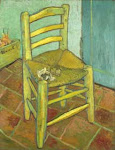.jpg)
In early September 1888, Vincent took as his subject the Cafe de la Gare in the Place Lamartine of Arles, staying up three nights in a row to paint. While cafes and restaurants had been an earlier interest, especially during his time in Paris, Vincent's approach to this particular cafe was different. His letters to Theo explain he wanted to show "a place where one could ruin oneself, go mad, or commit a crime," and to achieve this goal, he used bright colors and complementary color pairs. The all-night cafe feels oppressive and filled with loneliness -- empty chairs, mostly empty absinthe glasses -- the antithesis of the more cheerful "Cafe Terrace at Night" painted not long after.
Today this painting belongs to the Yale University Art Gallery, but I saw it most recently in a Met exhibition last summer. Seeing it in person again after many years, I was surprised what I noticed. That bouquet of pink flowers on the sideboard is lost in a flat photograph, but on the actual canvas its thickly applied paint draws the eye right away. It strikes a note of innocence and hope in an otherwise gloomy room. I listened that day as a college student tour group came to see the painting; Vincent would have been pleased at the wrinkled noses and exclamations of "That's ugly!"
Another story lingers in this painting: the identity of the man beside the pool table. He's Joseph Ginoux, owner of the Cafe de la Gare, at the time Vincent's landlord (Vincent moved to the yellow house about a month later). Vincent maintained a friendship with Ginoux and his wife Marie during his time in Arles, and came to visit them while at Saint-Remy. What he didn't know--and what he never learned--was that Joseph Ginoux (along with other Arlesians) signed a petition in February 1889 to forcibly confine Vincent in the Arles hospital, following a relapse. Ginoux's name is clearly visible in the original document, and his testimony appears elsewhere in police records. Why did Ginoux betray his friend? We'll never know.(See Martin Gayford's book The Yellow House for recent discussion.)
Today the site of the night cafe no longer exists. It's a parking lot now, the original building having been damaged in World War II.






No comments:
Post a Comment